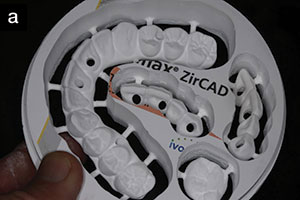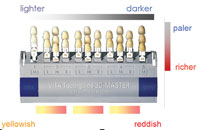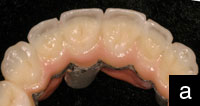This article describes an economical, one-piece device and clinical technique (Cosmetic Aligner [Cosmetic Aligner]) that eases midline and horizontal plane communications to the laboratory. The device is used to register the anterior midline and the horizontal plane during dental treatment. Since these alignments are frequently difficult to determine from master models alone, the device easily transfers the information after tooth preparation. This information is critical to communicate to the lab technician for fabrication of anterior crowns and veneers that provide an excellent cosmetic result.
CASE REPORT
 |
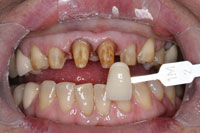 |
|
Figure 1. This patient’s smile does not match her facial features. |
Figure 2. Old crowns are removed and the teeth prepared. Digital photo is taken of the chosen shade. |
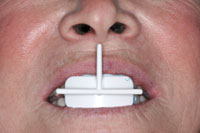 |
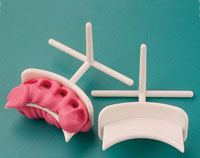 |
|
Figure 3. The Cosmetic Aligner is placed between the patient’s upper and lower teeth after tooth preparation, and is positioned in the correct midline and horizontal plane. |
Figure 4. The upper and lower portions of the Cosmetic Aligner are filled with impression material. |
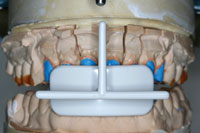 |
|
Figure 5. The laboratory technician places the Cosmetic Aligner on a master model and marks the midline and horizontal plane. |
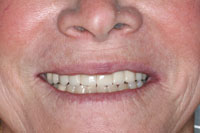 |
 |
|
Figures 6 and 7. Using the Cosmetic Aligner, aesthetic restorations are placed with the correct midline and horizontal plane. |
As seen in Figure 1, this patient’s smile does not match her facial features. The dentition is slightly tilted to her left, and her upper laterals and cuspids do not match symmetrically. The midline and horizontal plane are not aligned properly. She also would like to whiten her smile.
I removed her old central incisor crowns and prepared teeth Nos. 6 to 12 for veneer restorations. A digital photo was taken with the chosen shade to help our lab tech see the entire picture and have a visual of the patient (Figure 2). I will use a whitening procedure to lighten her lower dentition to complement her entire appearance.
At this point the Cosmetic Aligner was used to communicate to our lab tech exactly where we wanted the midline and horizontal plane. The device was placed between the patient’s upper and lower teeth after tooth preparation and was positioned in the correct midline and horizontal plane (Figure 3).
The technique involves brushing the upper portion of the Cosmetic Aligner with adhesive and filling it with quick-set (30 seconds) bite material (Figure 4). Position the Cosmetic Aligner over the prepared teeth where the midline and horizontal planes are desired. The use of facial landmarks such as the eyes, nose, and lips help determine where to position the Cosmetic Aligner. The prepared teeth barely touch the plastic as the material sets. Fill the lower portion of the Cosmetic Aligner with adhesive and quick-set bite material. Reposition the Cosmetic Aligner on the upper prepared teeth and have the patient close down lightly to make an impression of the lower teeth. Allow the material to set without distorting the position of the Cosmetic Aligner. This technique is not used for bite registration. The occlusal bite is taken separately using the same fast bite registration material.
The laboratory technician places the device on the master model and marks the midline and horizontal planes (Figure 5). The final check of the completed crowns or veneers is done by removing the upper bite material and placing the lower impression on the articulated models. This determines if the midline and horizontal planes are correct before returning the case back to the dentist.
Using the Cosmetic A-ligner takes the guesswork out of doing cosmetic cases and does not leave the dentist at the mercy of the lab. You can expect consistently beautiful restorations placed right where you want them (Figure 6). The Cosmetic A-ligner replaces the cumbersome, inaccurate use of the cross stick-bite impression method and is easier, faster, and more economical than other sophisticated articulation equipment. The lab will also find that the number of redo cases is significantly reduced because the technician has the additional information that is not available from models alone.
As you can see in Figure 7, the Cosmetic Aligner plays a major role in making this patient’s smile fit her face, achieving a beautiful and predictable smile makeover.
Dr. Meulener graduated from the University of Medicine and Dentistry of New Jersey in 1979 and has been in general practice in Little Silver, NJ, for 28 years. He can be reached at (877) 586-7396 or by visiting cosmeticaligner.com.
Disclosure: Dr. Meulener has a patent pending for the Cosmetic Aligner and is president of Cosmetic Aligner.





